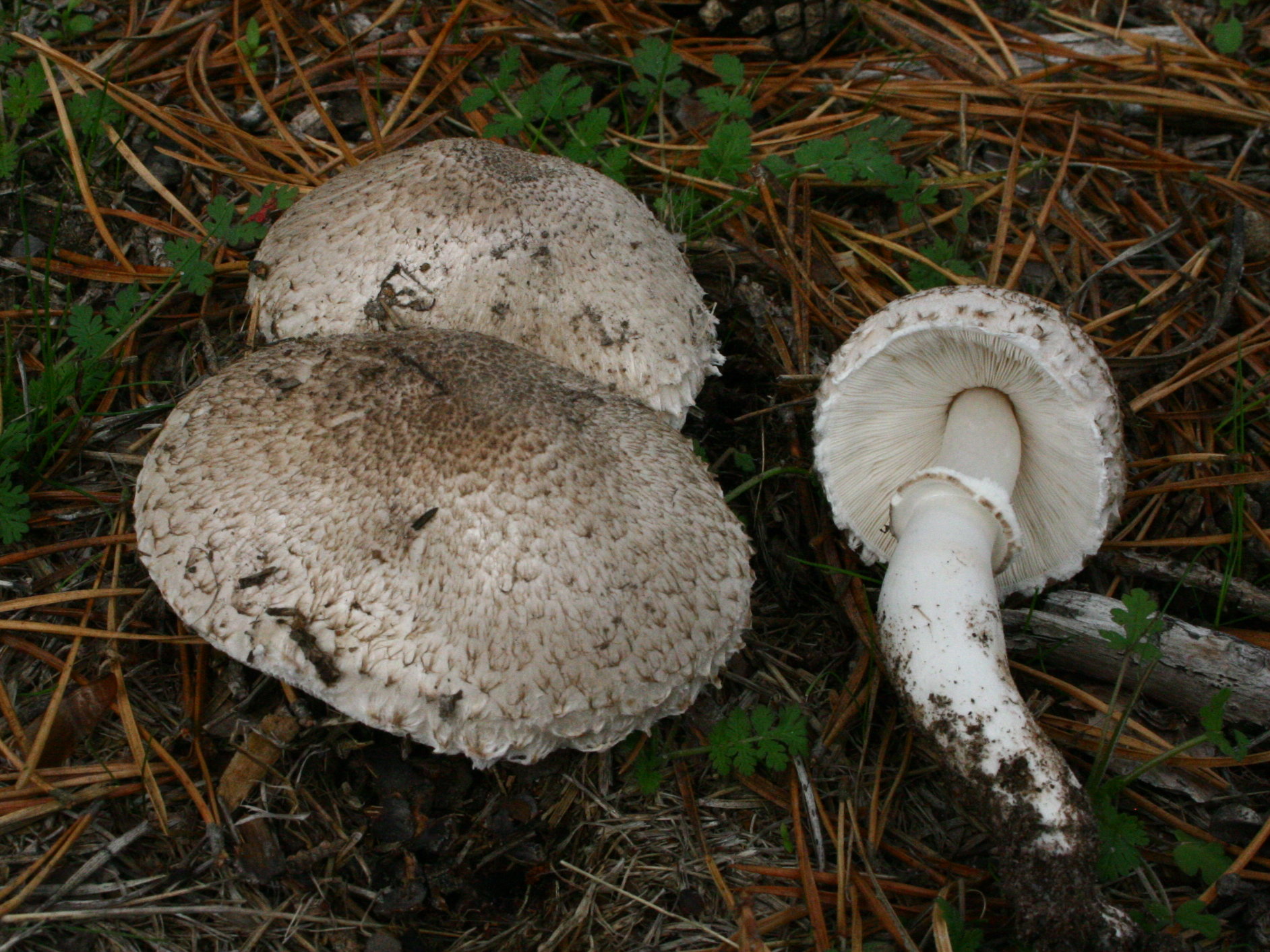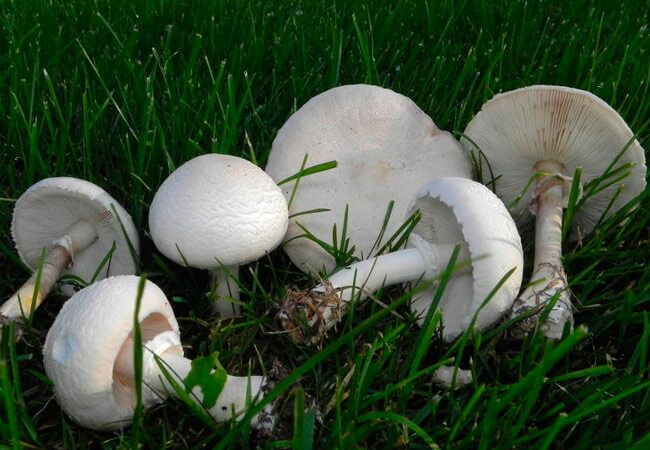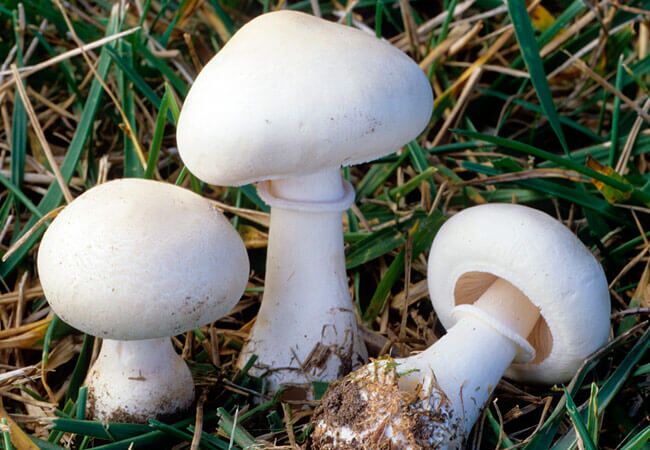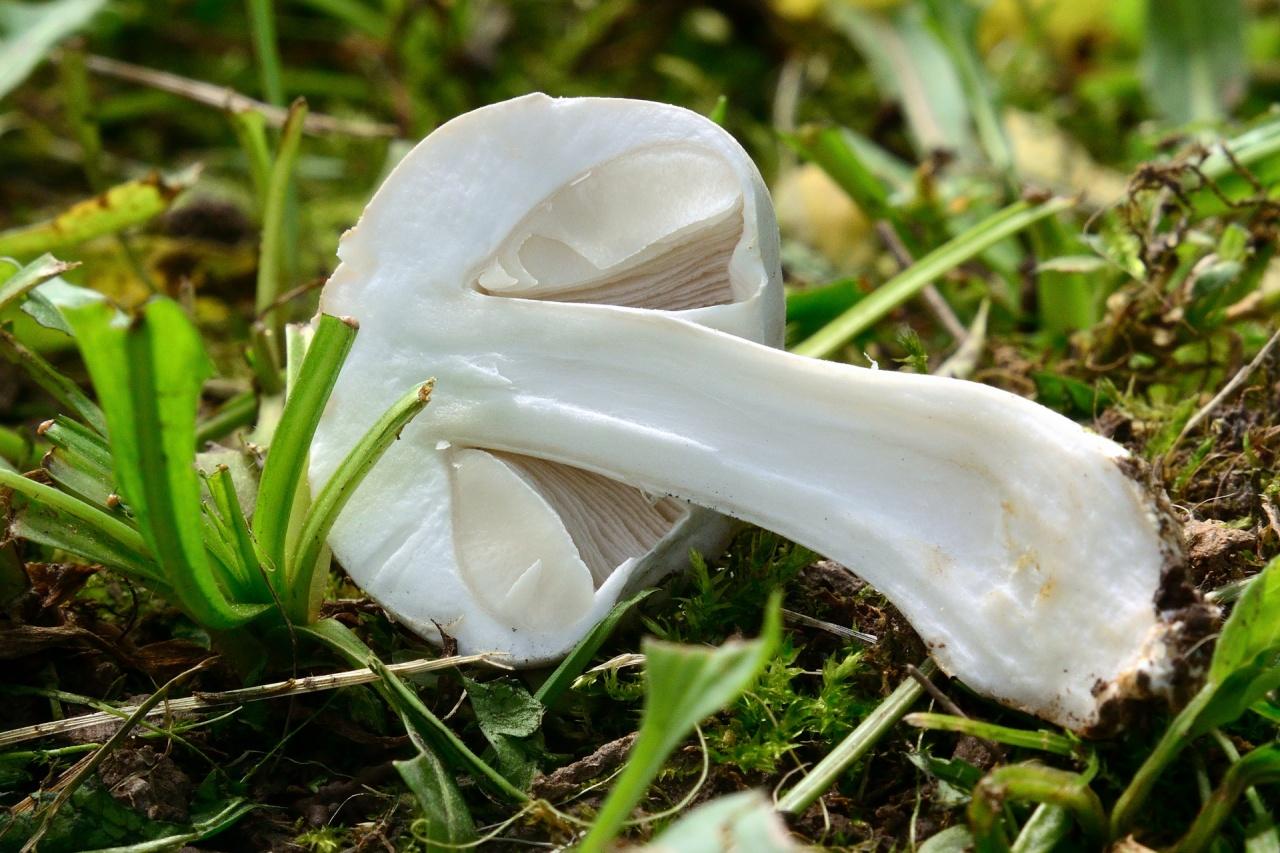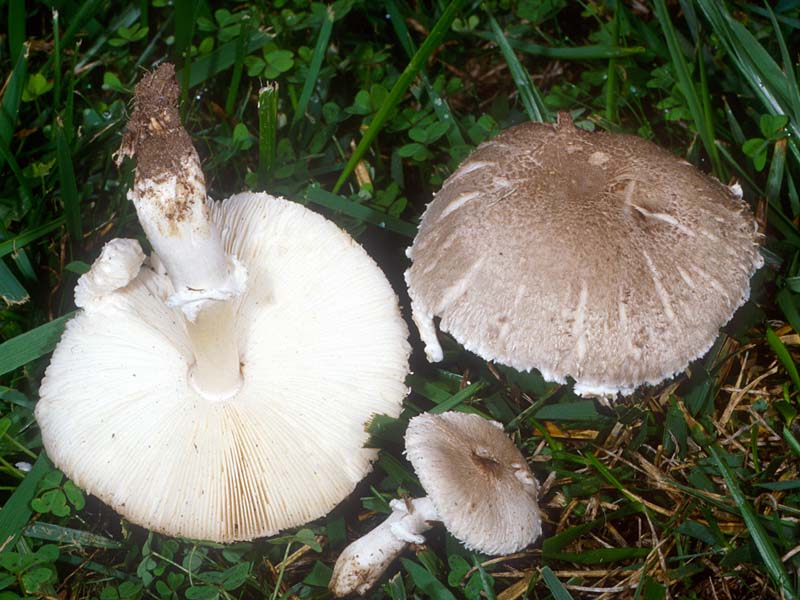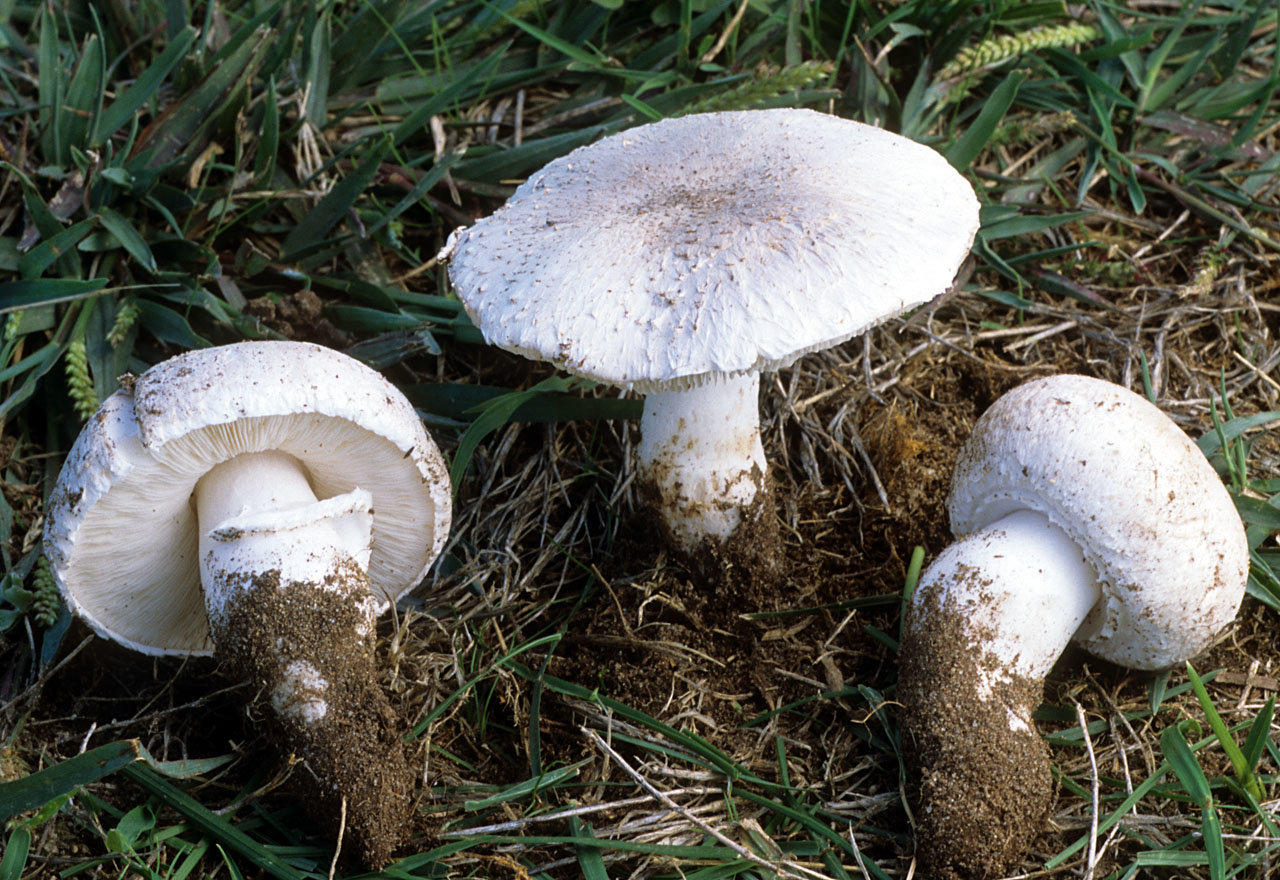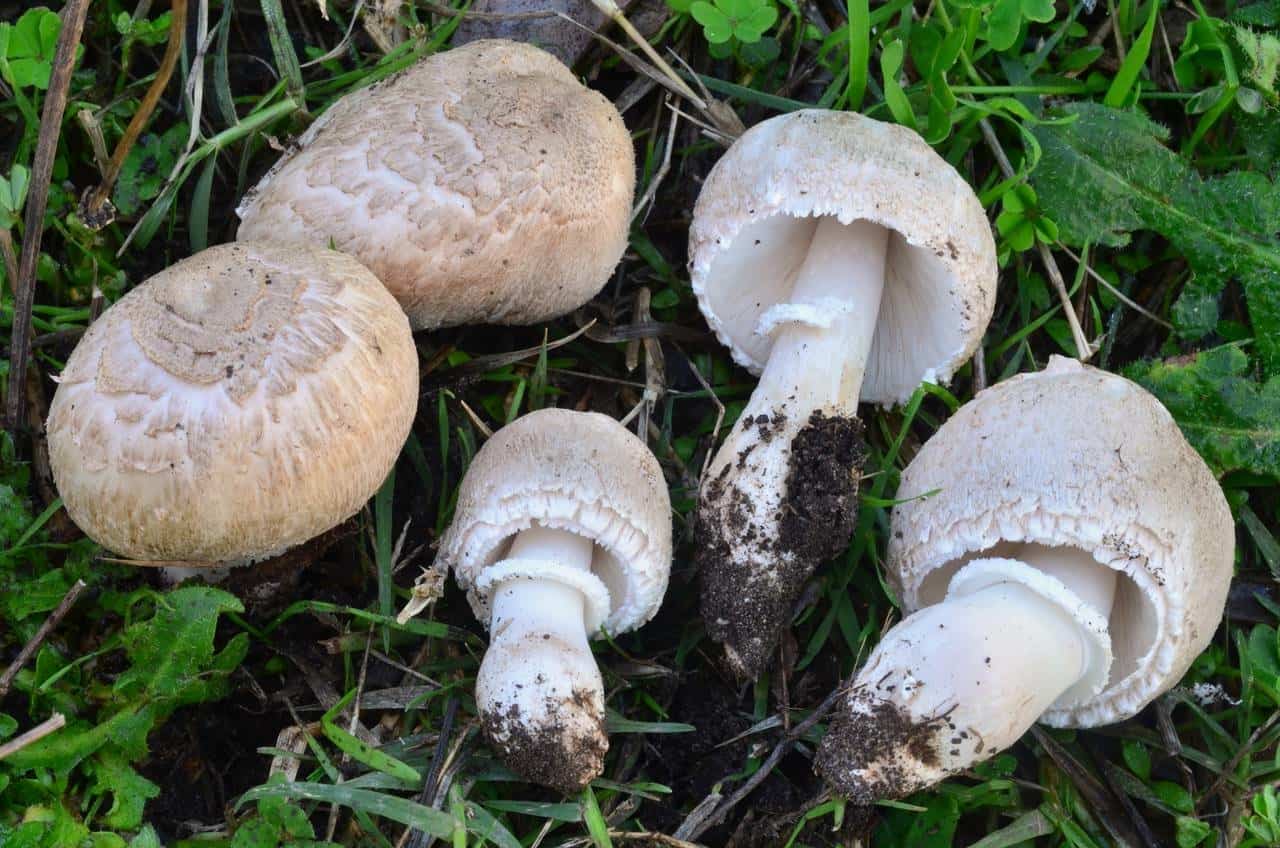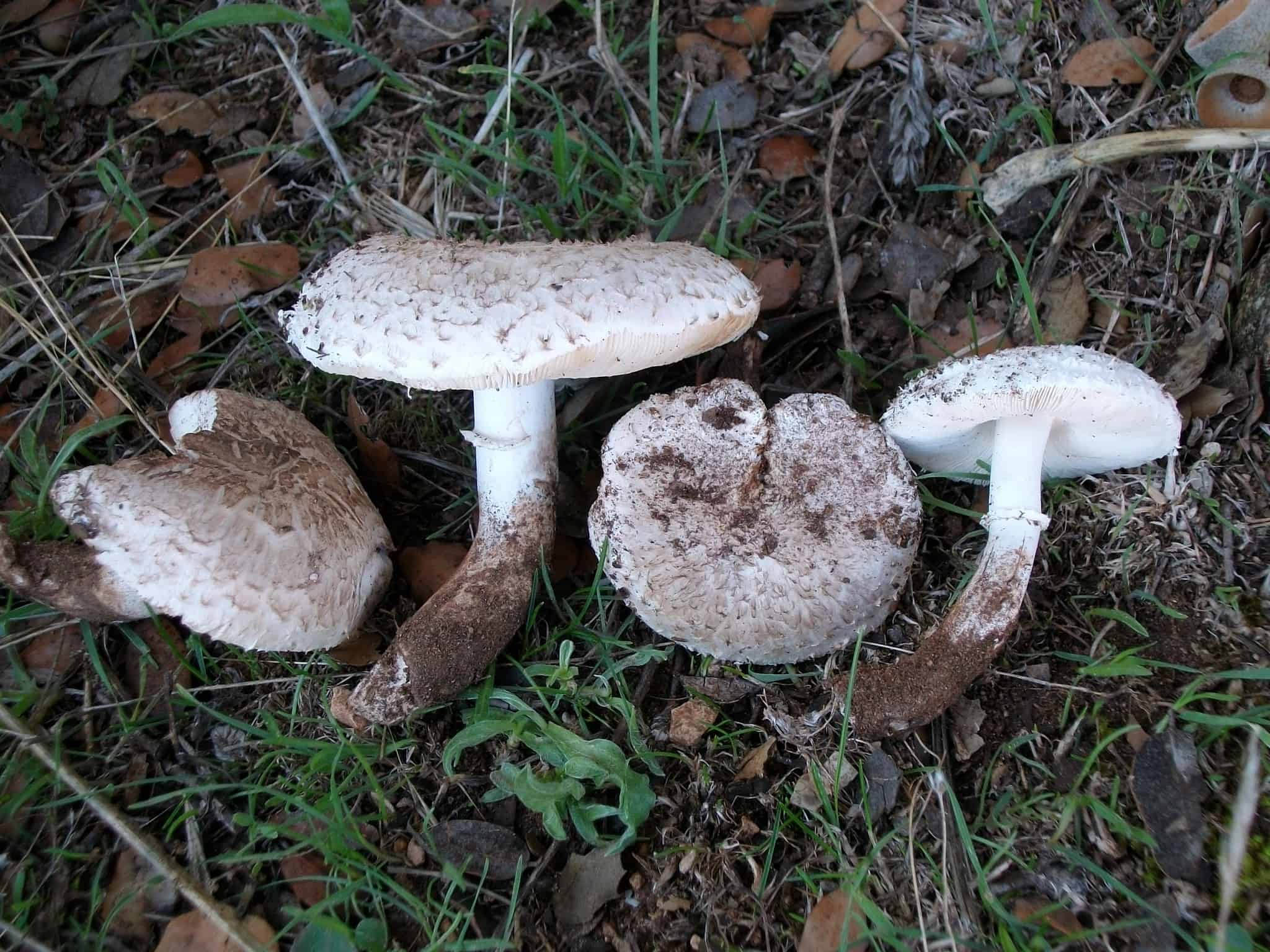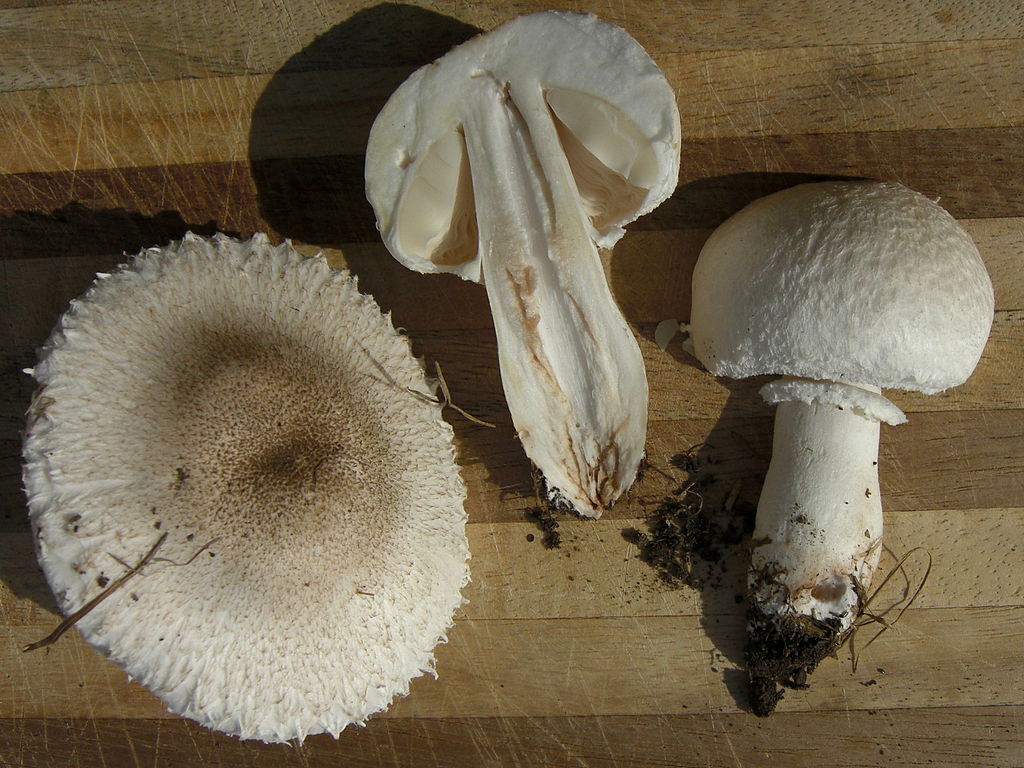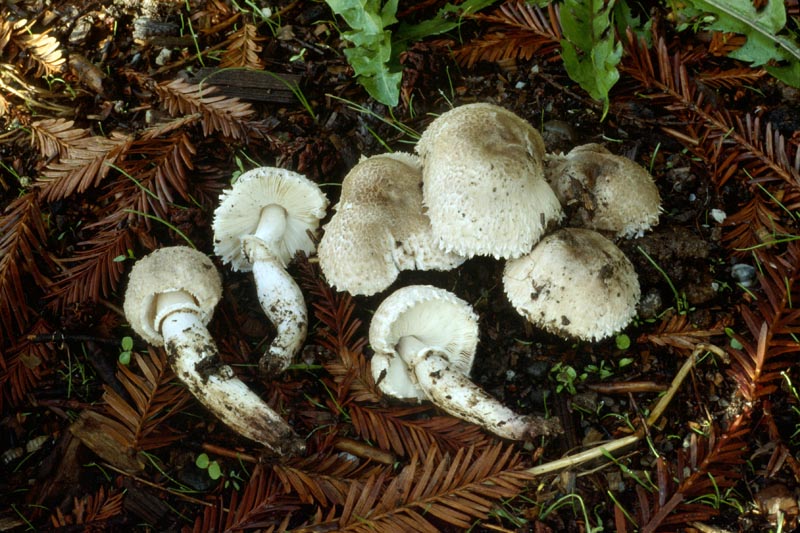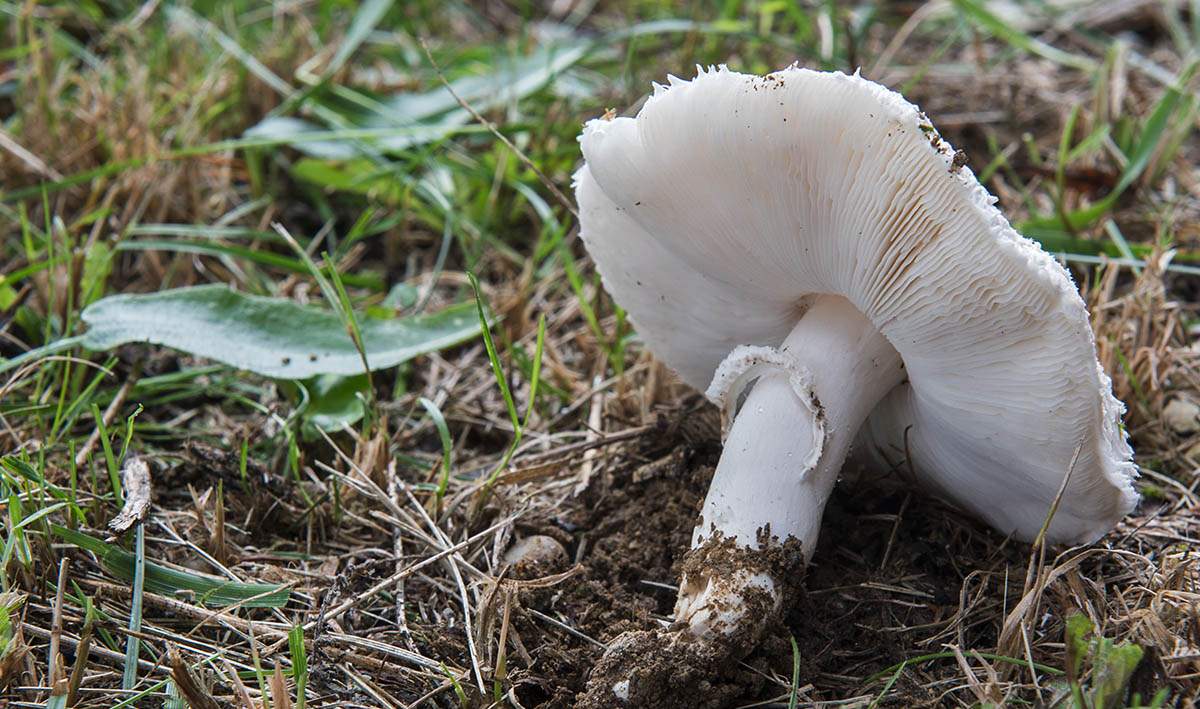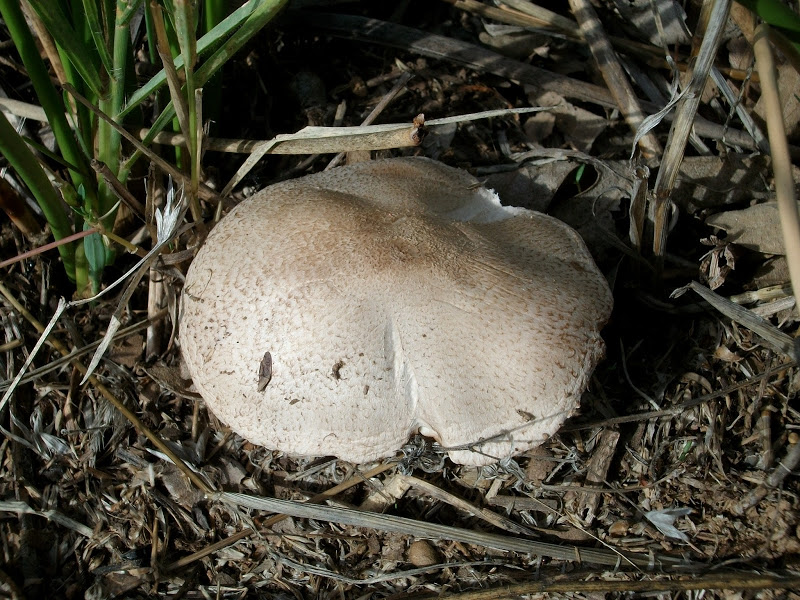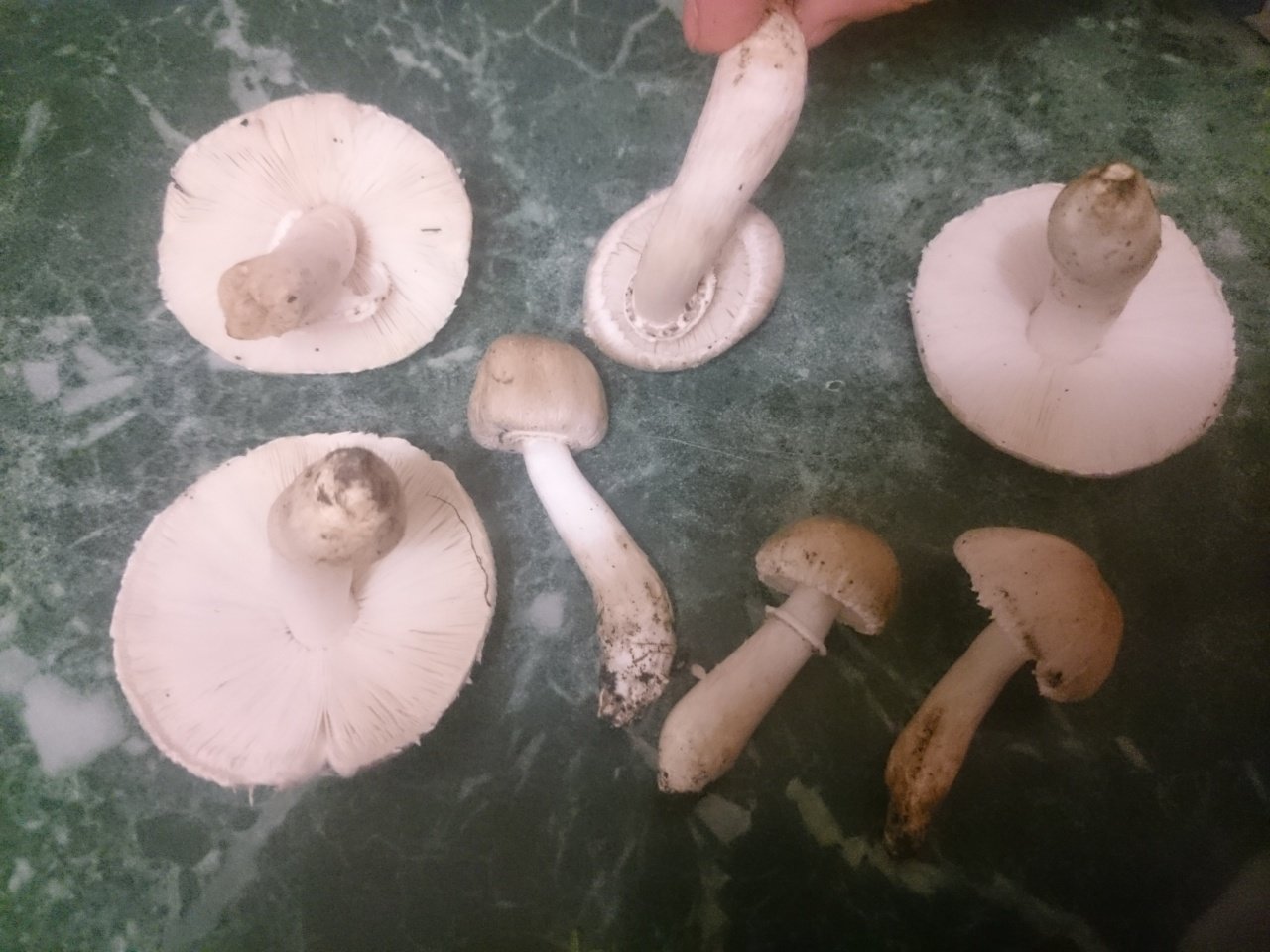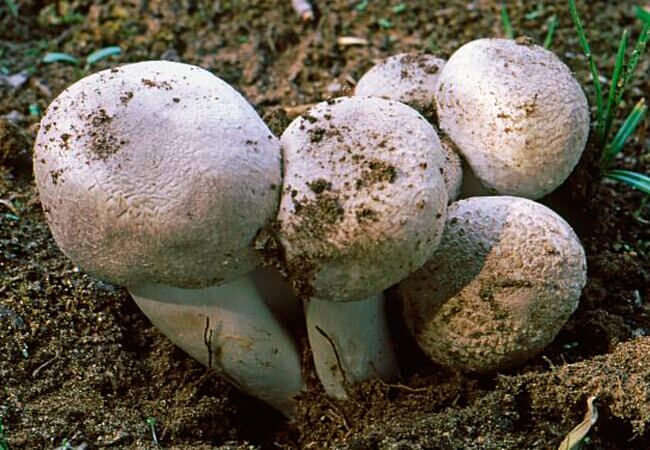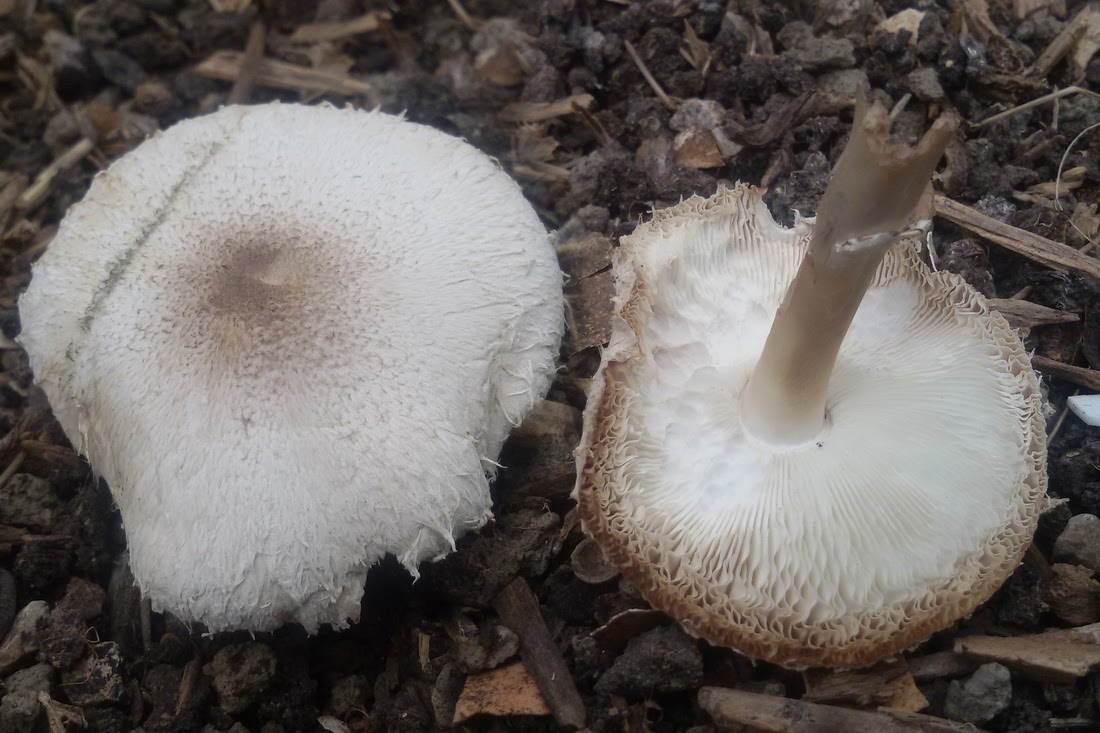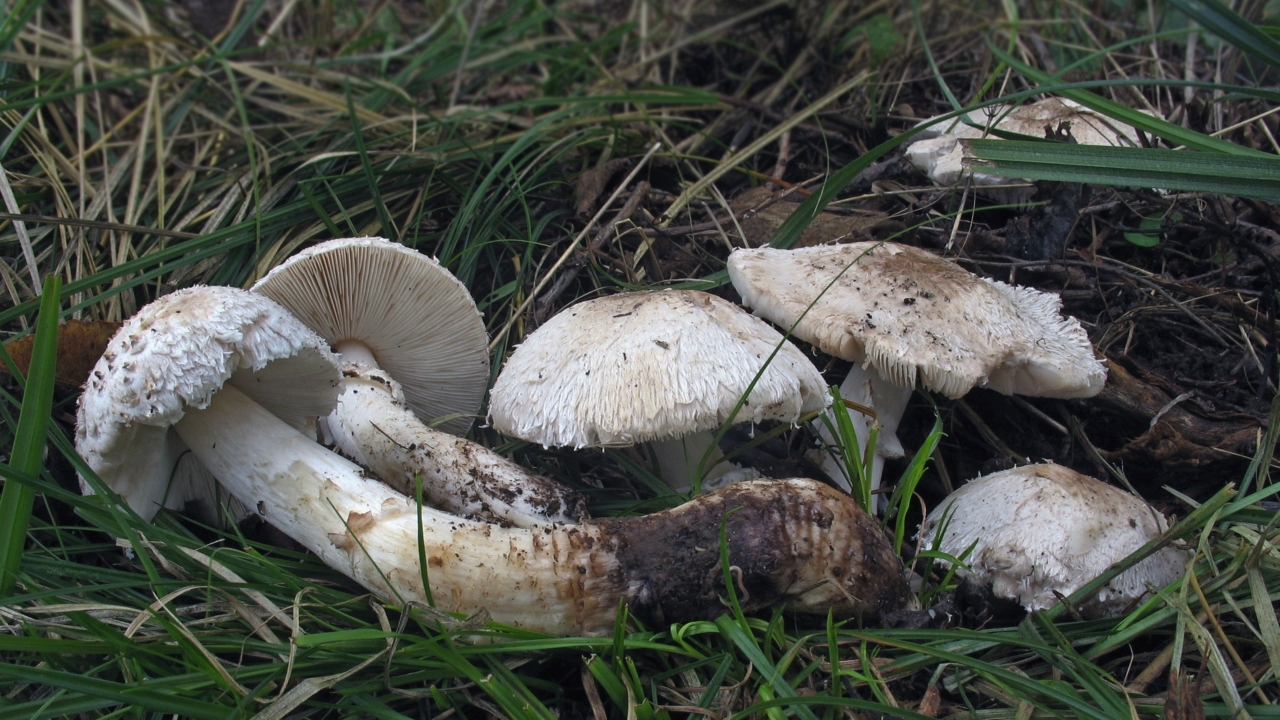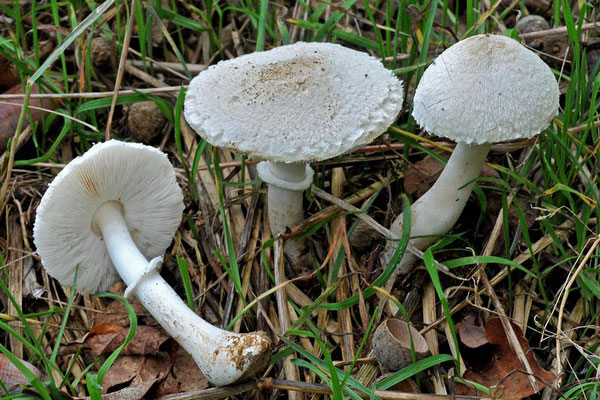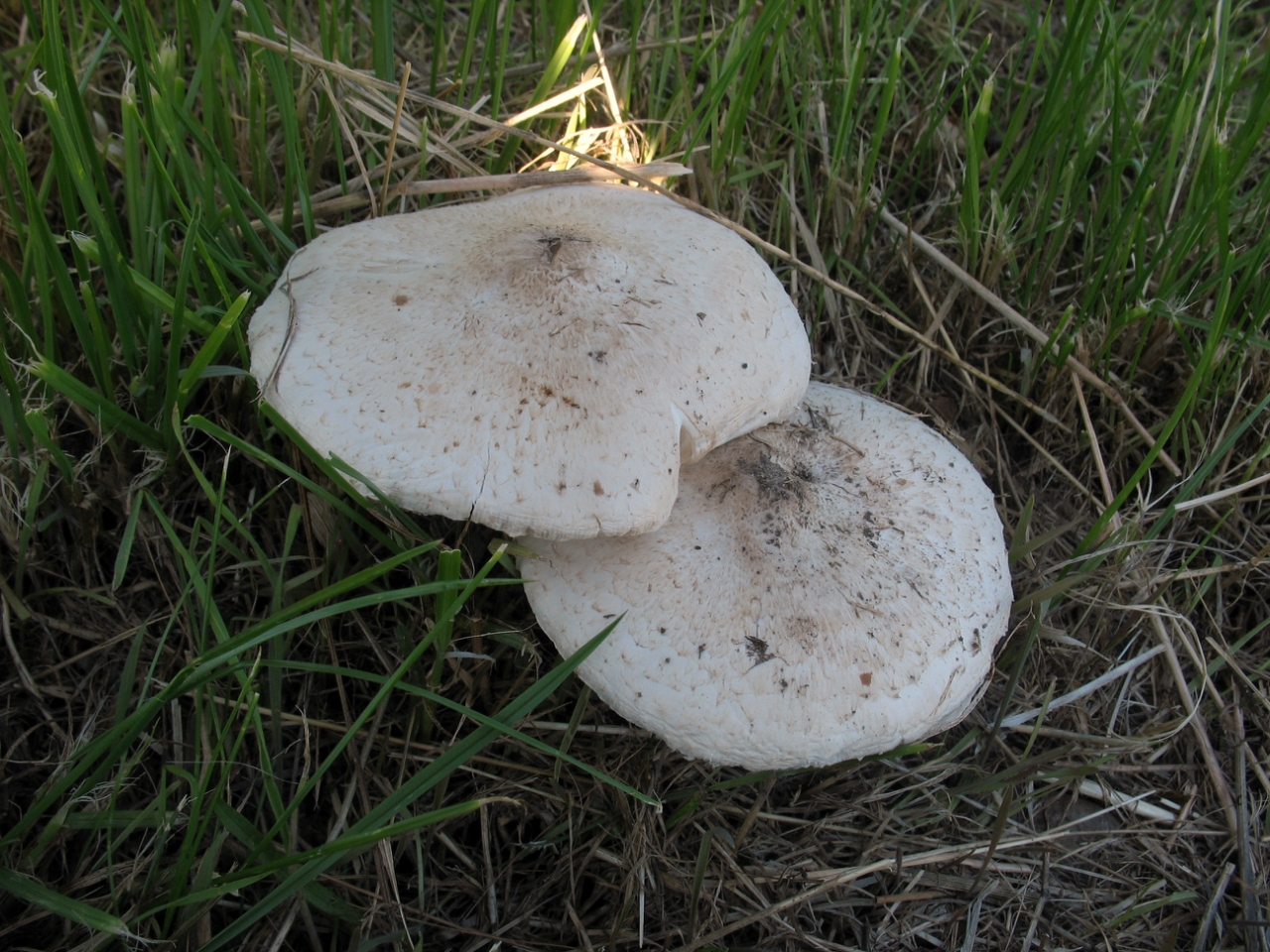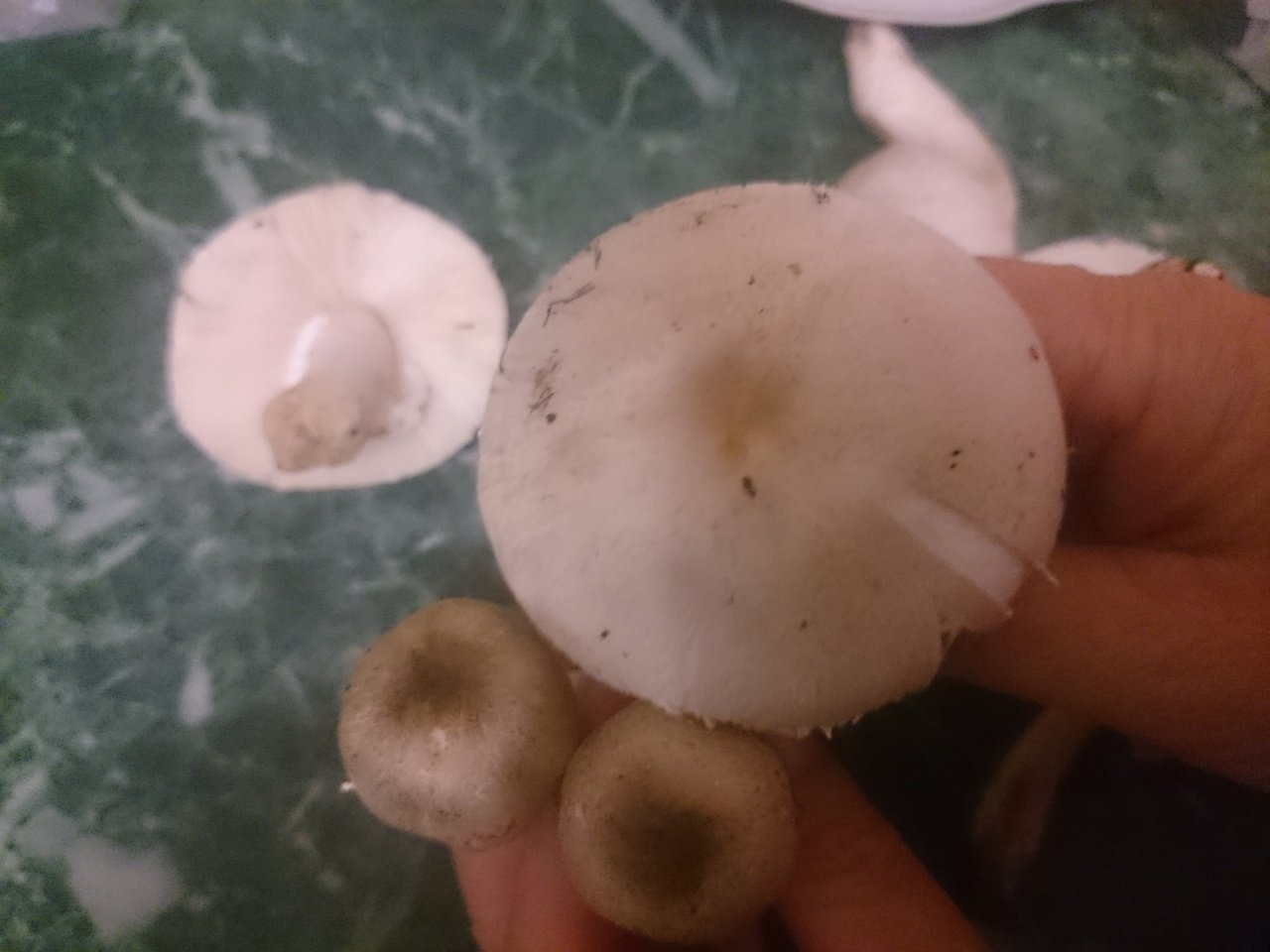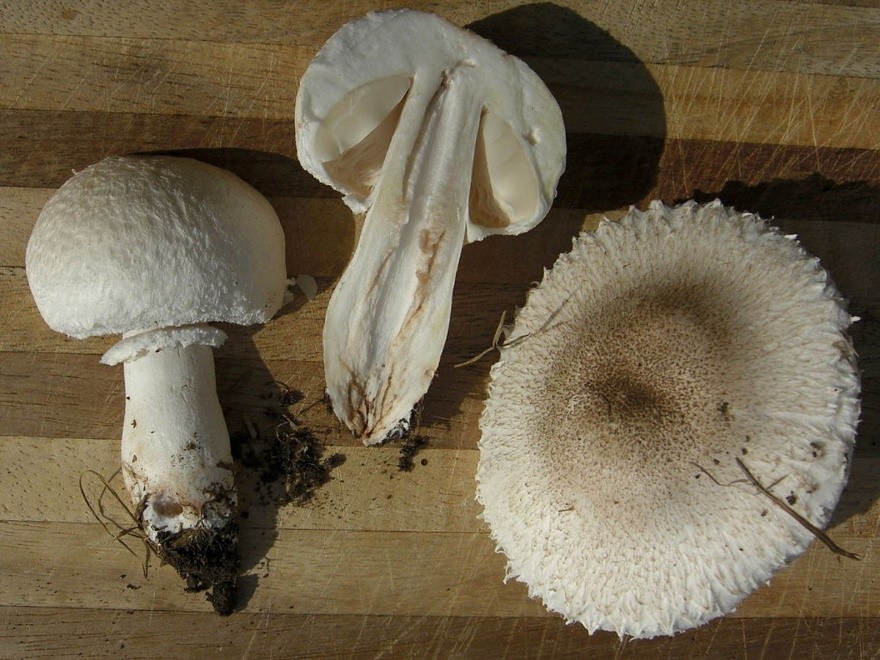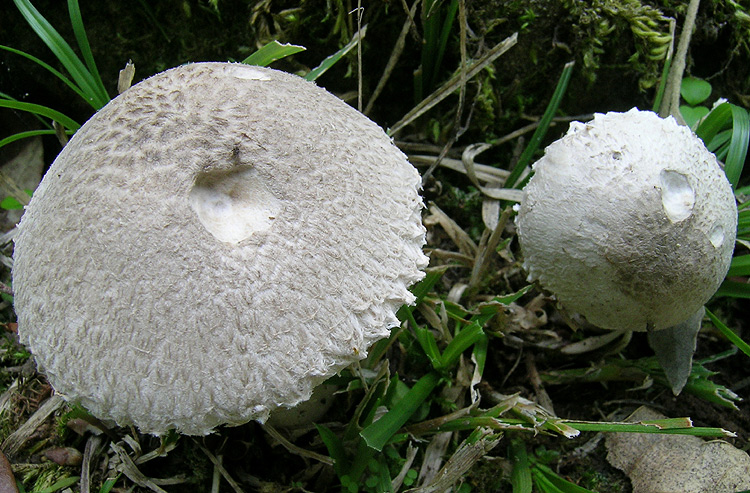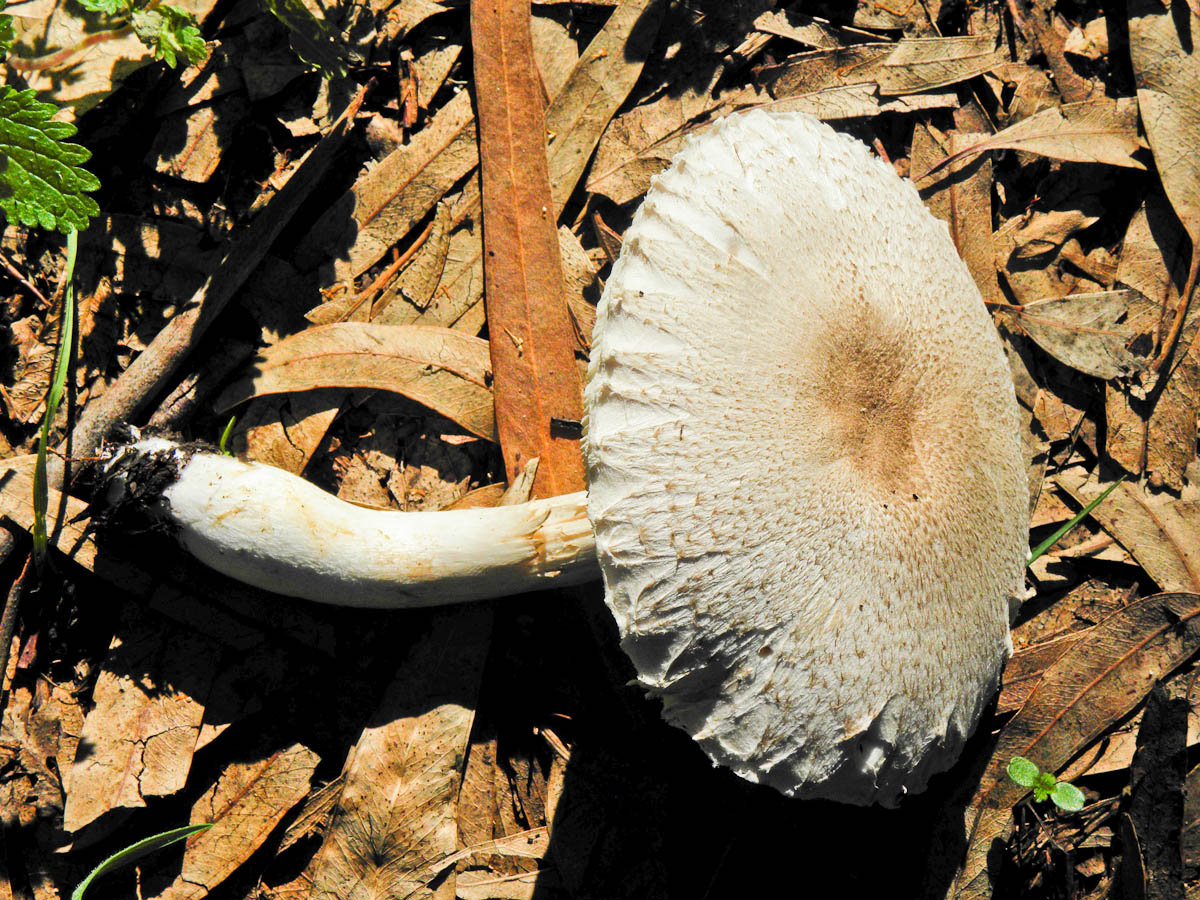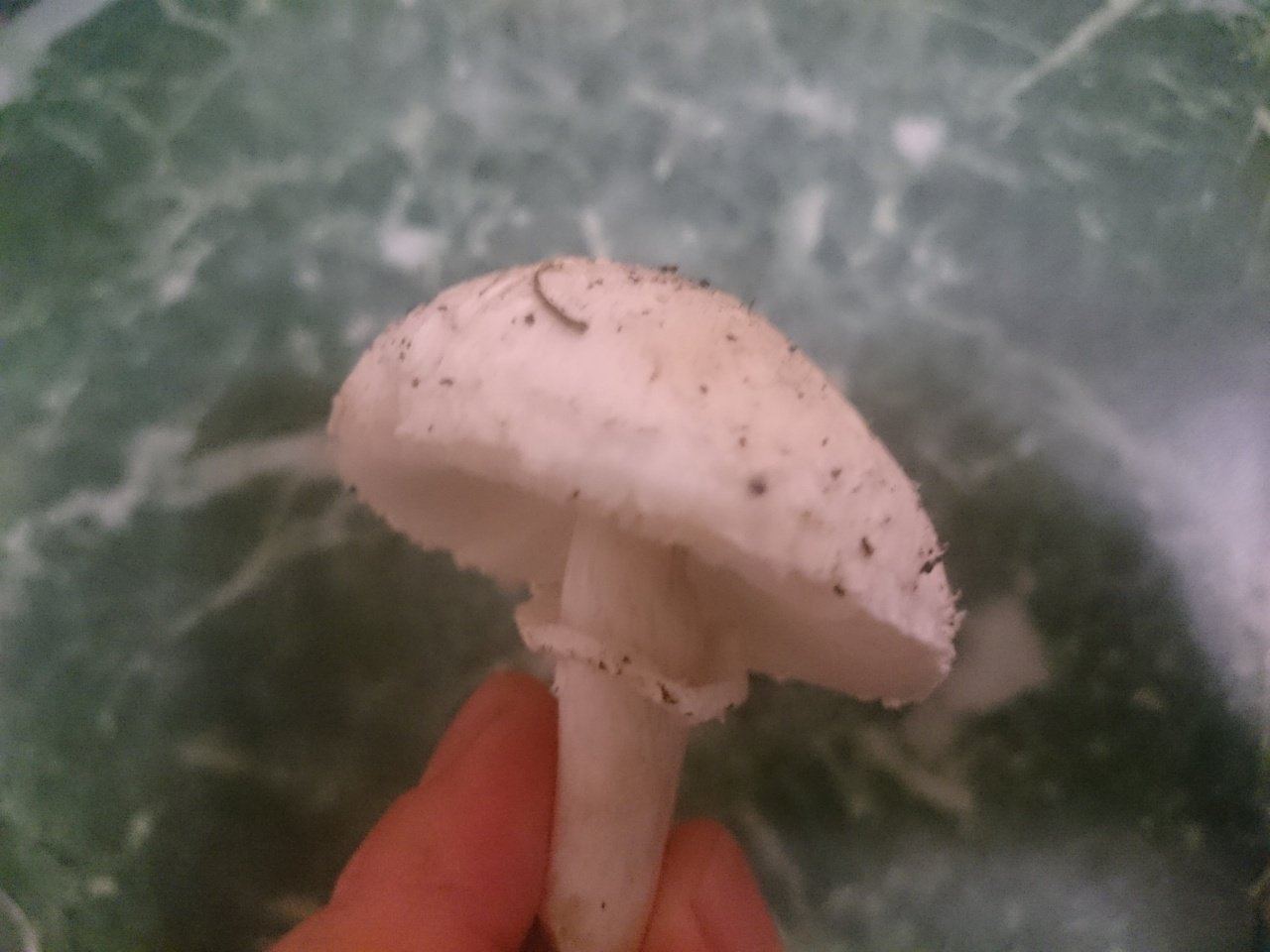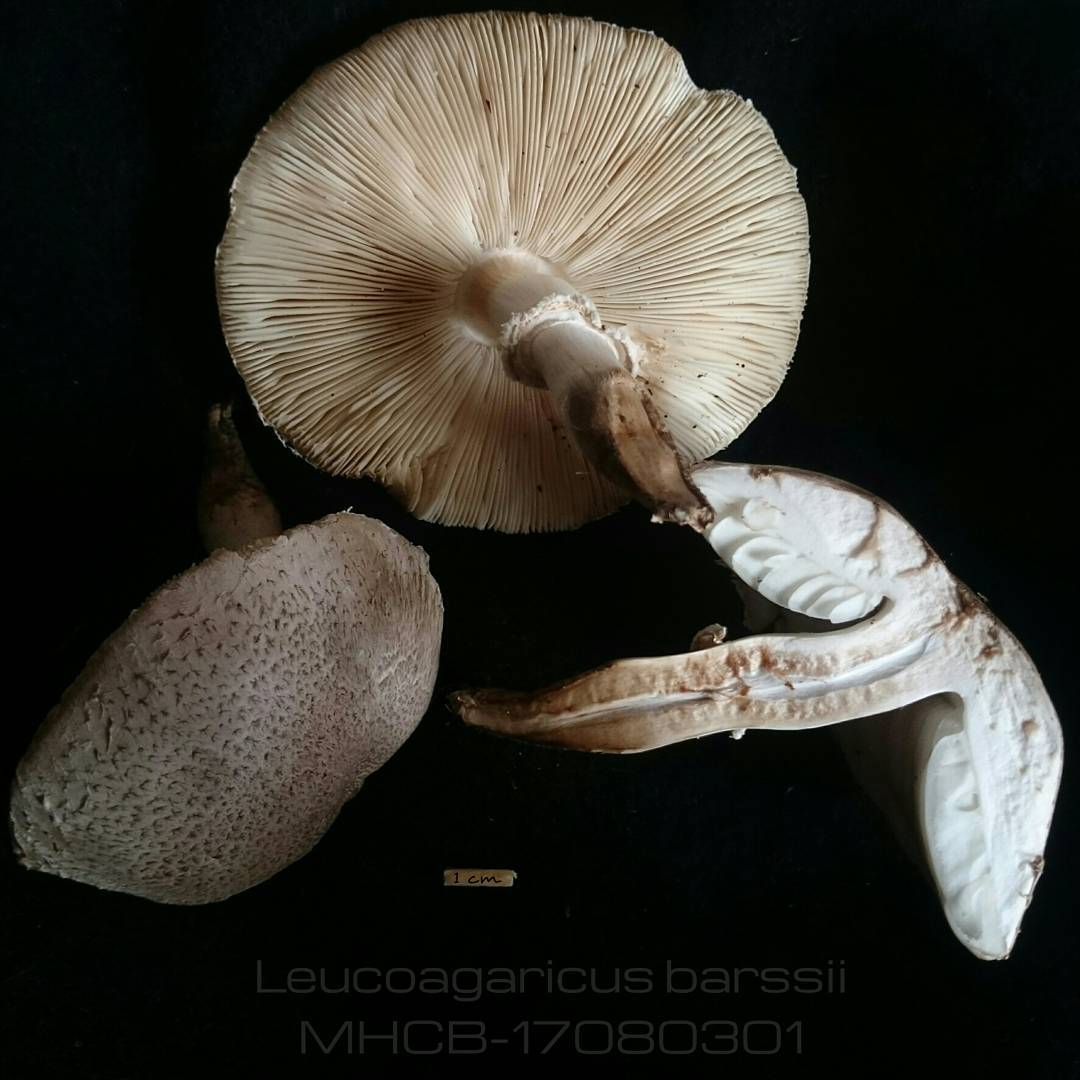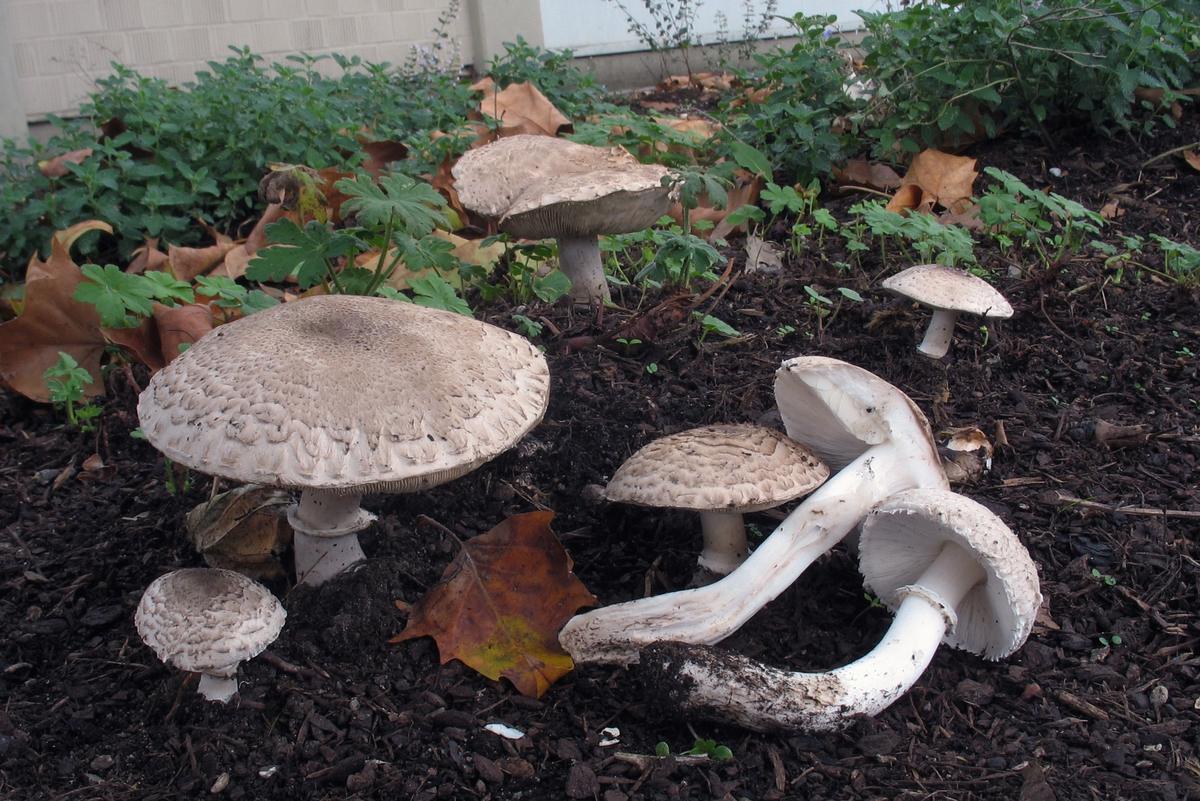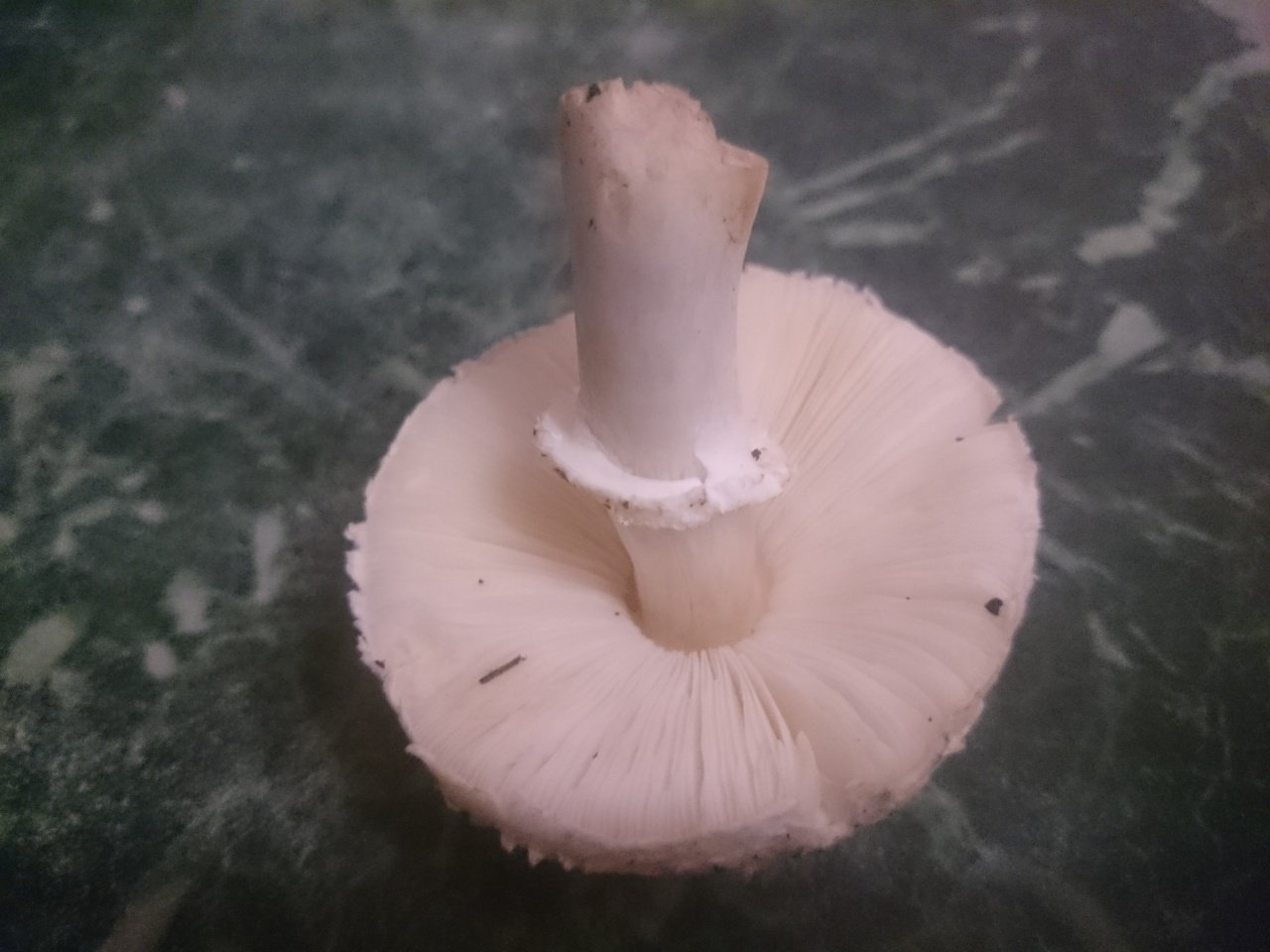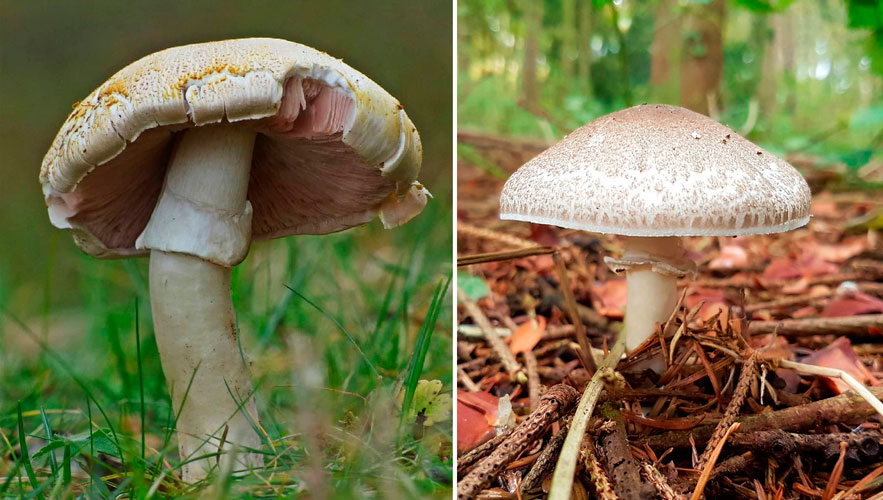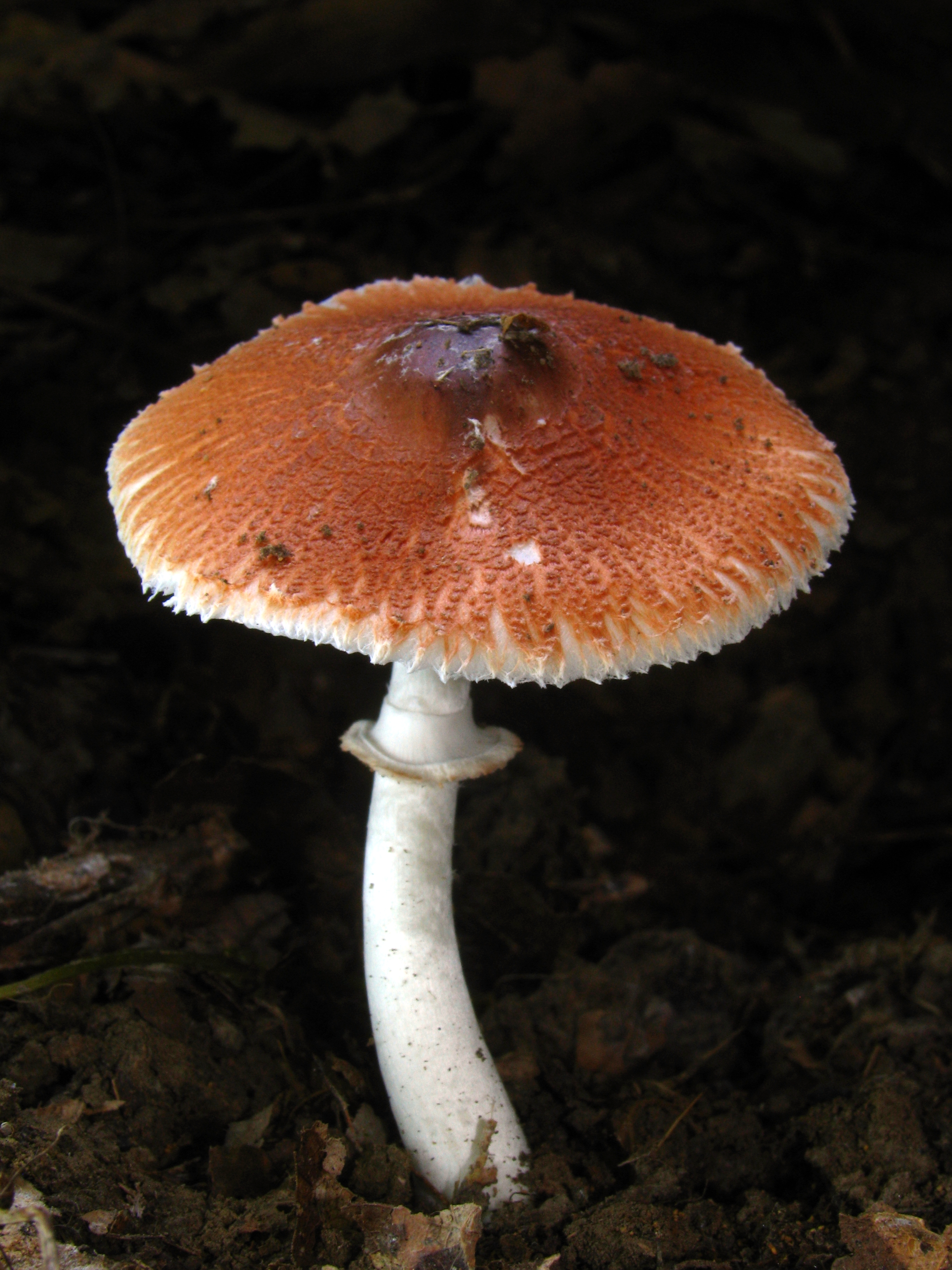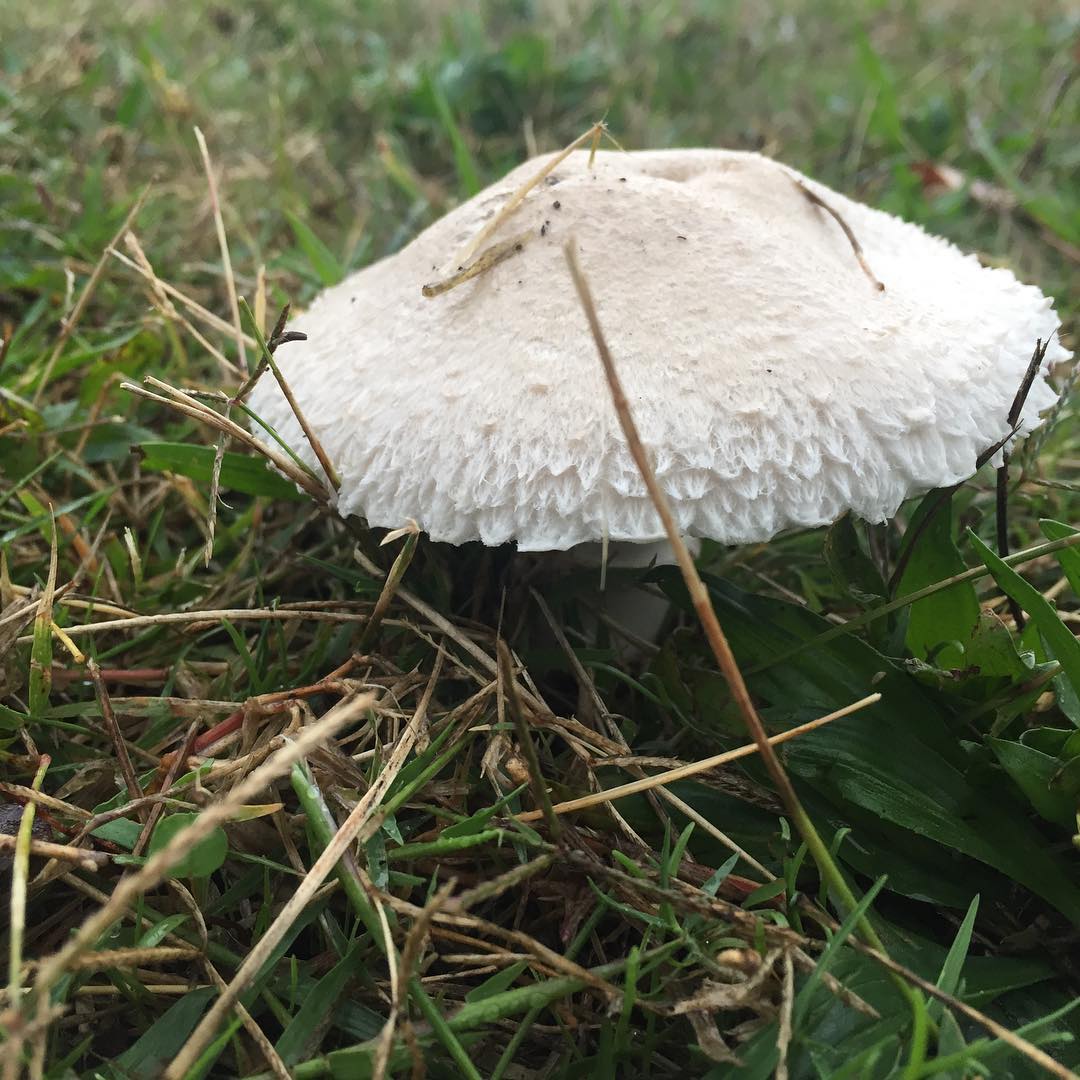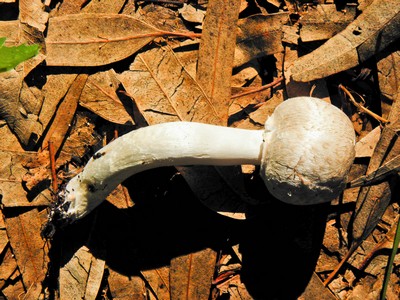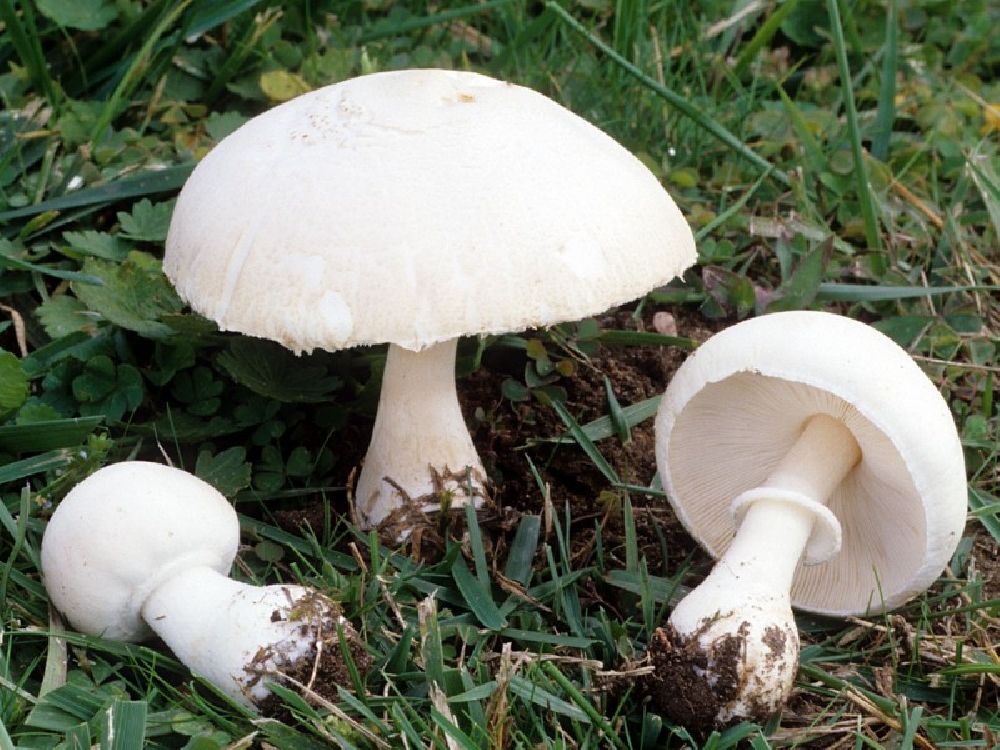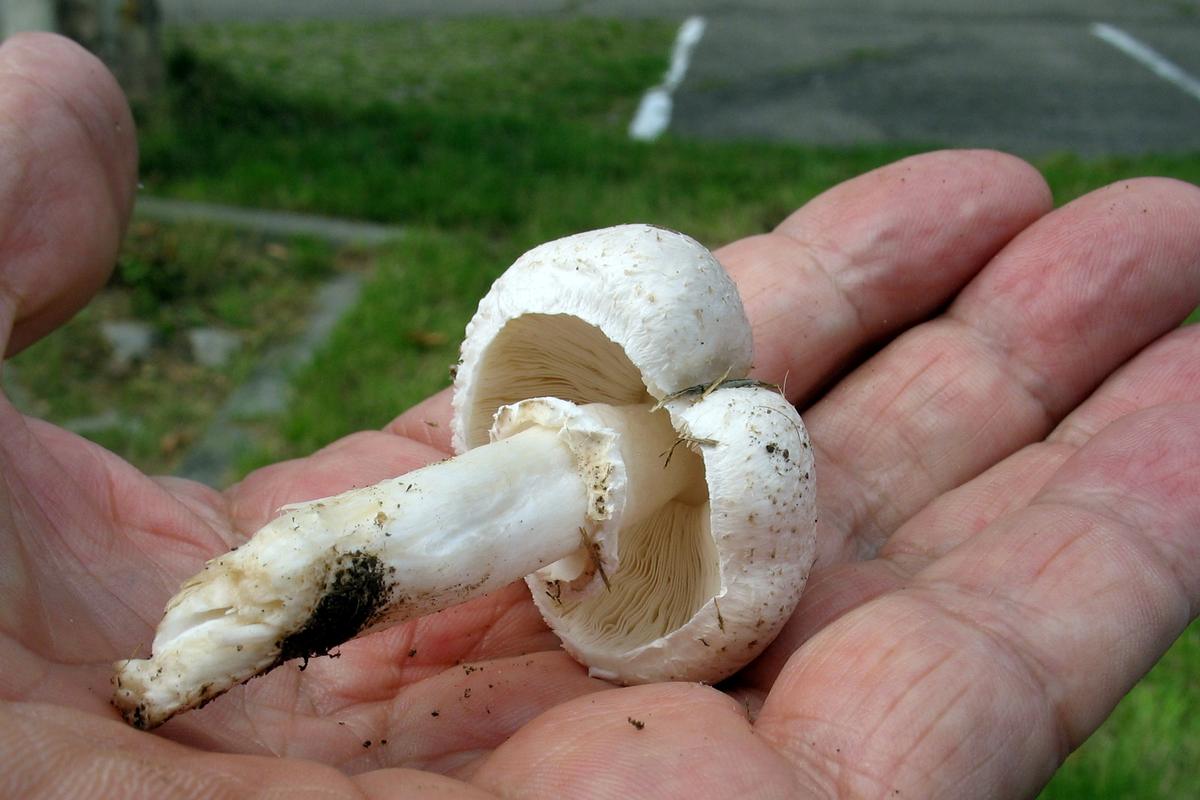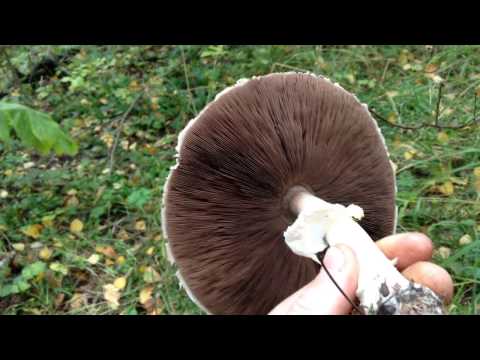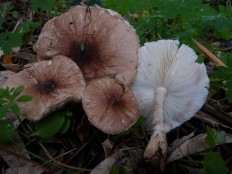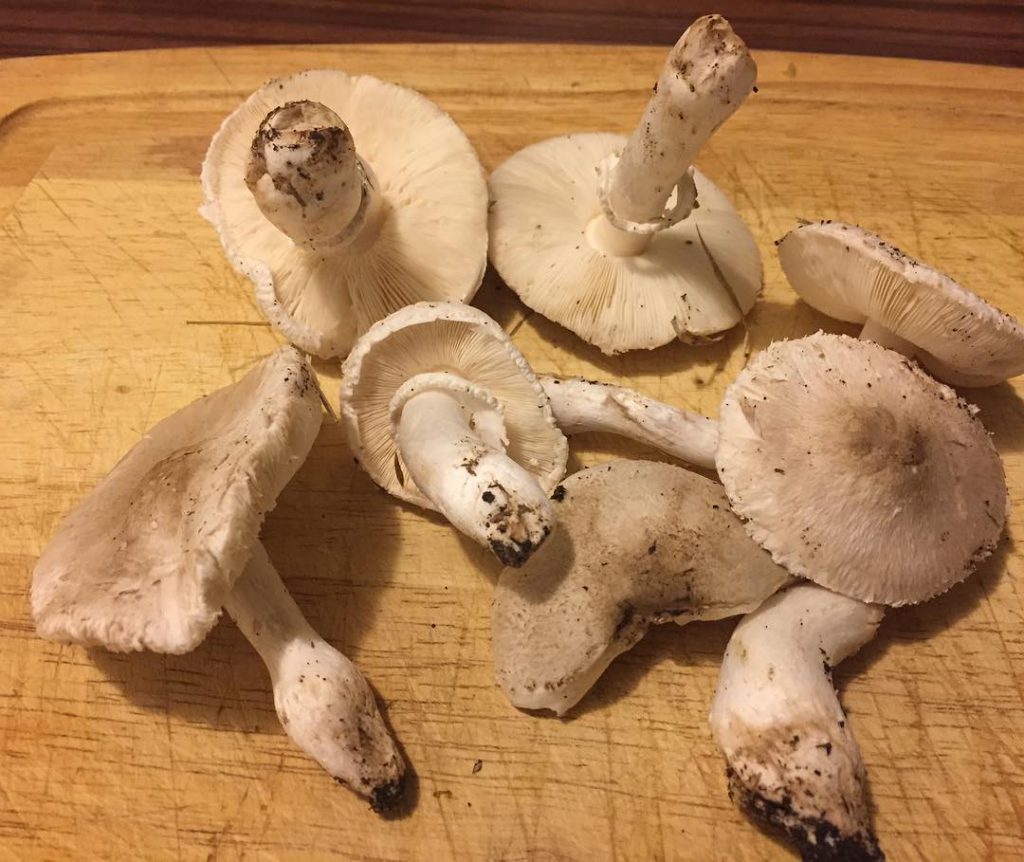Notes (edit)
- Singer R. Diagnoses fungorum novorum Agaricalium // Sydowia. - 1948. - No. 2. - P. 26-42.
- Moser M. Die Röhrlinge und Blätterpilze (Agaricales). - 3. Aufl. (Kleine Kryptogamenflora Begründet von H. Gams). — Jena: Fischer, 1967. — Bd. 2b. T2. 443 S.
- Singer R. The Agaricales in modern taxonomy. - Vaduz: Cramer, 1975.
- Singer R. The Agaricales in modern taxonomy. - Koenigstein: Koeltz Sci. Books, 1986.
- Mushrooms: Handbook / Per. with ital. F. Dvin. - M.: "Astrel", "AST", 2001. - S. 65. - ISBN 5-17-009961-4.
- Wasser describes L. leucothites and L. holosericeus as different species; according to online databases L. holosericeus - synonym.
Belochampignon long-root
Long-rooted white champignon (Latin Leucoagaricus barssii) is an edible, lamellar mushroom of the Champignon family (Agaricaceae), class Agarokomycetes. Has a characteristic convex-outstretched cap.
Hat
Diameter from 40 to 130 mm. Young mushrooms have a spherical cap, adult mushrooms have a hemisphere or convexly outstretched. There may be a tubercle in the middle of the cap. In young mushrooms, the edge of the cap can be tucked up. The surface is fleecy or scaly with uneven edges. The color of the cap is grayish brown or whitish, with a darker color in the middle.
White champignon long-rooted belongs to the lamellar mushrooms. The plates are thin, loose, often located, cream-colored. When damaged, the plastics do not darken; when dried, they acquire a brown color. Belochampignon has many plates.
Spore powder, spores
Spores of Belochampignon are long-rooted, oval or ellipsoidal, dextrinoid, spore size 6.5-8.5 - 4-5 microns. Spore sac of white or whitish-cream color.
Leg
Leg height from 40 to 130 mm, diameter from 10 to 30 mm. Has a clavate shape. The base of the stem grows deep into the ground with long, tapered underground formations. When touched, it takes on a brown tint. There is a simple white ring on the leg, it can be located in any part of the leg - in the upper, middle or lower. It also happens that it may be absent.
Pulp
The pulp is dense, white, slightly grayish under the skin. Has a strong mushroom smell. The mushroom tastes sweet, reminiscent of walnuts.
When and where it grows
Belochampignon long-rooted can be found from June to October. It can grow both singly and in small groups. A very rare species, listed in the Red Book of Ukraine. It prefers to grow in parks, gardens, arable lands, forests, on roadsides. Distributed in Europe and Asia, Australia, North Africa and North America. On the territory of the Russian Federation, it is distributed in the vicinity of Rostov-on-Don, and is unknown in other regions of the country. It grows in Great Britain, France, Ukraine, Italy, Armenia.
Eating
Belochampignon long-root is a very tasty, edible mushroom that can be eaten fresh. Has a strong mushroom smell. The mushroom is sweetish in taste and has a walnut aroma. Belochampignon long-root can be pickled, dried, fried.
Similar species
Long-rooted white champignon can be confused with any mushroom from the genus Champignon, such as: Red-colored white champignon (Latin Leucoagaricus leucothites), Double-peeled champignon (Latin Agaricus bisporus), Curve champignon (Latin Agaricus abruptibulbus) (Agest. Meadow champignon (lat.Agaricus campestris), two-ring champignon (lat.Agaricus bitorquis), an umbrella mushroom (lat.Macrolepiota excoriata) and many other edible and inedible similar types of mushrooms.
Attention! Poisonous doubles
Long-rooted white champignon can be confused with scaly species of poisonous mushrooms, which differ in the shade of caps, plates and have a pharmacy smell. The mushroom has poisonous counterparts such as Lepiota scaly (Latin Lepiota brunneoincarnata), Yellow-skinned champignon (Latin Agaricus xanthodermus), Variegated champignon (Latin Agaricus moelleri), Flat-headed champignon (Latin Agaricus placomyces).
Place of growth
The mushroom is rare, it has already been mentioned that it is inscribed in the Red Book and is protected by law. It can be found in gardens, parks, glades in the forest, fields, meadow steppes, forest-steppes, ruderal thickets, in the grass on the side of the road. Distributed in Europe and Asia, North America, North Africa and Australia.In Ukraine, it is found in the Khmelnytsky region, Letychivsky district, the village of Medzhibozh and in the Sumy region, Krasnopolsky district, near the village of Taratutino. On the territory of the Russian Federation, it grows near Rostov-on-Don, and in the rest of the country, the population is unknown. In such European countries as Great Britain, Italy, France and Armenia, there is a small number of long-rooted white champignon.
Belochampignon long-rooted: where it grows, what it looks like, is it possible to eat, the rules of collection
The genus was first described in 1948 by R. Singer, who placed in it some of the species Lepiota s. l. and attributed it to the tribe Leucocoprinae Singer 1948, which he himself established, together with several morphologically similar genera (Belonavoznik ( Leucocoprinus ), Macrolepiota ( Macrolepiota ), Chlorophyllum ( Chlorophyllum ), Volvolepiota ). Understanding the volume of labor Leucocoprinae there were disagreements between researchers, many species were transferred from one genus to another within this tribe, and sometimes within a family or order. With the advent and development of methods of molecular phylogenetics, the composition of genera is being actively revised. Until 1975, 6-18 species described at that time were attributed to the genus Belochampignon, by 1990 - up to 26 species. According to the 2008 Ainsworth and Bisbee Dictionary of Mushrooms, the genus contains about 90 species.
Description
Description of the genus by morphological characters without taking into account the data of molecular phylogenetics
- Type of development of the fruiting bodypileocarpous.
- The cap is thick, rarely thin fleshy, with or without a tubercle. The surface is often bare, sometimes the skin is cracked and small granular granules or large pressed scales in the center are formed.
- The plates are free, often with colarium, frequent, thin, the edge of the plates is even. The color of young plates is white; with age, they often darken. The tram of the plates is wrong.
- The stem is cylindrical, central, at the base it expands into a tuber or narrows and forms an underground tapered outgrowth. The ring is simple, wide, lagging, motionless.
- Spore powder of whitish or whitish-cream color. Spores are dextrinoid, metachromatic, colorless, or slightly pinkish, creamy, sometimes germinating, ellipsoidal, almond-ellipsoidal or ovoid, up to 10 nm long, smooth, ornamented in some species.
From the kind of Lepiota ( Lepiota ) Belochampignon differs mainly in the habitus of fruit bodies and spores that have a time for germination. Morphologically the closest genera are Belonavoznik and Makrolepiota. The genus differs from the whiteheads by the character of the cap surface and the habitus of the fruiting bodies, from the macrolepiots - by an immobile ring on the stem and the size of the spores.
Ecology
White champignons are found in forests and outside forests, in clearings, forest edges, in fields, parks, steppes, forest belts. Representatives are known both in temperate climates and in the tropics, on all continents except Antarctica.
Practical value
The edibility or toxicity of most species has not been studied. Some species are edible, but due to their rarity or difficulty in pinpointing, they are usually not harvested.
The ruddy white champignon, also known as the nut umbrella, or hazel lepiota, is considered to be of high quality, but it is recommended for picking only by the most experienced mushroom pickers, since this mushroom is easily confused with poisonous ones.
List on the site "Encyclopedia of Life" and other sources:
- Leucoagaricus amanitoides R.M. Davis & Vellinga 2006
- Leucoagaricus americanus (Peck) Vellinga 2000
- Leucoagaricus barssii (Zeller) Vellinga 2000
- Leucoagaricus brunneocingulatus (P.D. Orton) Bon 1976
- Leucoagaricus carneifolius (Gillet) Wasser 1977 - Belochampignon corpuscular
- Leucoagaricus cinerascens (Quél.) Bon & Boiffard 1978
- Leucoagaricus croceovelutinus Bon 1976
- Leucoagaricus crystallifer Vellinga 2000
- Leucoagaricus crystalliferoides T.K.A. Kumar & Manim. 2009
- Leucoagaricus dacrytus Vellinga 2010
- Leucoagaricus georginae (W.G. Sm.) Candusso 1990
- Leucoagaricus glabridiscus (Sundb.) Wuilb. 1986
- Leucoagaricus gongylophorus (Möller) Singer 1986
- Leucoagaricus griseodiscus (Bon) Bon & Migl. 1991
- Leucoagaricus ionidicolor Bellù & Lanzoni 1988
- Leucoagaricus irinellus Chalange 1999
- Leucoagaricus leucothites (Vittad.) Wasser 1977 - Rudened Belochampignon, or Walnut Umbrella
- Leucoagaricus marriagei (D.A. Reid) Bon 1976
- Leucoagaricus medioflavoides Bon 1976
- Leucoagaricus meleagris (Sowerby) Singer 1952
- Leucoagaricus menieri (Sacc.) Singer 1968
- Leucoagaricus moseri Wasser 1978 - Moser Belochampignon
- Leucoagaricus nympharum (Kalchbr.) Bon 1977
- Leucoagaricus pilatianus (Demoulin) Bon & Boiffard 1976
- Leucoagaricus purpureolilacinus Huijsman 1955
- Leucoagaricus serenus (Fr.) Bon & Boiffard 1974
- Leucoagaricus sericifer (Locq.) Vellinga 2000
- Leucoagaricus subcretaceus Bon 1981
- Leucoagaricus sublittoralis (Kühner ex Hora) Singer 1969
- Leucoagaricus tener (P.D. Orton) Bon 1977
- Leucoagaricus viridiflavoides B.P. Akers & Angels 2000
- Leucoagaricus wichanskyi (Pilát) Bon & Boiffard 1974
Species attributed by some authors to the genus Belochampignon and transferred to other genera:
Similar species
Mushrooms belonging to the Champignon family are all alike in themselves. In general, there are about 70 types of champignons, almost all of them are harmless, except for some double champignons, which are dangerous to human life and health.
It is worth learning to distinguish between them:
- Motley champignon has a pungent unpleasant odor, which scares away those who want to feast on it. It is really very similar to the long-rooted white champignon, except that its scales are not felt, they adjoin tightly to the surface of the cap, which creates the effect of a speckled ocher color. At the break, the flesh of the mushroom darkens. This representative belongs to conditionally poisonous mushrooms, that is, its toxicity is controversial.
- Scaly lepiota or scaly umbrella also belongs to the Champignon family, but at the same time it is a very dangerous and deadly fungus, as it contains cyanides and hydrocyanic acid. As you know, cyanides have a fruity-almond aroma, which is also characteristic of this mushroom. And the older the mushroom, the richer the aroma it emits. This species is most similar to white champignon. They can be distinguished only by the plates, which are rarely planted in the lepiota.
- Yellow-skinned champignon has a feature by which you can easily distinguish this mushroom. When pressed on the cap or leg, as well as when cut, its pulp becomes bright yellow. In addition, when boiled and roasted, this one gives off an unpleasant phenolic odor. This mushroom is poisonous and can provoke severe intestinal upset.
Belochampignon long-root CC of the Rostov region
Description
The cap is 4–13 cm in diameter., At first hemispherical, later convex-prostrate, with or without a tubercle in the center, coarse-fibrous, whitish or grayish-brown, darker in the center, with large monochromatic scales. The edge of the cap in young fruiting bodies is tucked up, then more often it straightens or bends up. The plates are loose, frequent, thin, creamy, brown when dry. Stem 4–8 (12) x 1.5–2.5 cm, fusiform or clavate, narrowed towards the base, with a long underground root-shaped formation, slowly turns brown when touched. The private veil is fibrous-membranous, white; the ring is central or apical, white, sometimes absent. The pulp is thick, dense, white, grayish under the skin of the cap, brown at the break, with a pronounced smell and taste of walnut. Spore powder, whitish-cream. Spores are smooth, thin-walled, ovate or ellipsoidal, light cream, 6.5–8.5 × 4.0–5.5 µm.
Spreading
Grows in Europe (Ukraine, Great Britain, France, Italy), in the Caucasus (Armenia), in Africa (Morocco); in Russia it is known only in the Rostov region. ... - In the Rostov region. occurs in the Aksai district ("Schepkinsky forest massif") and on the territory of Rostov-on-Don (the village of Temernitsky Sovkhoz; city parks).
Features of biology and ecology
Humus saprotroph. It grows on soils and substrates enriched with organic substances in artificial forest plantations, forest belts, parks, gardens, in fields and arable lands, in ruderal thickets. Bears fruits VI – XI.
Number
Very rare; fruiting both in single fruiting bodies and in small scattered groups. Due to the location of the identified populations in the urban area, there is a tendency towards a decrease in the number of populations.
Limiting factors
Erroneous collection and destruction of fruit bodies by the population is possible. The specificity of the location of populations (the territory of the city and the immediate environs), due to intensive development and high recreational load, prevents the conservation of the species. The identified populations are endangered.
Security measures
Included in the QC of Ukraine (2009 as Leucoagaricus macrorhizus). It is necessary to control the state of populations and search for new locations. This mushroom should be promoted among the local population as rare and in need of protection. Artificial cultivation of the mushroom in protected areas is possible.It is advisable to separate it into a pure culture and preserve it as a part of mushroom collections of living cultures.
Practical value. The data on edible use are conflicting (for some - an edible mushroom with low palatability). Sources of information. 1. Wasser, 1980; 2. Pridyuk, 2009 a; 3. Chipped, 1990; 4. Vychepan, Rusanov, 1996; 5. Rusanov, Rebriev, 2013. Compiled. Rusanov V.A. Photo. Rebriev Yu.A.
Views
List on the site "Encyclopedia of Life" and other sources:
- Leucoagaricus amanitoides R.M. Davis & Vellinga, 2006
- Leucoagaricus americanus (Peck) Vellinga, 2000
- Leucoagaricus barssii (Zeller) Vellinga, 2000
- Leucoagaricus brunneocingulatus (P.D. Orton) Bon, 1976
- Leucoagaricus carneifolius (Gillet) Wasser, 1977 - Body-lamellar white champignon
- Leucoagaricus cinerascens (Quél.) Bon & Boiffard, 1978 - Belochampignon gray, or smoky
- Leucoagaricus croceovelutinus Bon, 1976
- Leucoagaricus crystallifer Vellinga, 2000
- Leucoagaricus crystalliferoides T.K.A. Kumar & Manim., 2009
- Leucoagaricus dacrytus Vellinga, 2010
- Leucoagaricus georginae (W.G. Sm.) Candusso, 1990
- Leucoagaricus glabridiscus (Sundb.) Wuilb., 1986
- Leucoagaricus gongylophorus (Möller) Singer, 1986
- Leucoagaricus griseodiscus (Bon) Bon & Migl., 1991
- Leucoagaricus ionidicolor Bellù & Lanzoni, 1988
- Leucoagaricus irinellus Chalange, 1999
- Leucoagaricus leucothites (Vittad.) Wasser, 1977 - Belochampignon ruddy, or nut umbrella
- Leucoagaricus marriagei (D.A. Reid) Bon, 1976
- Leucoagaricus medioflavoides Bon, 1976
- Leucoagaricus meleagris (Sowerby) Singer, 1952
- Leucoagaricus menieri (Sacc.) Singer, 1968
- Leucoagaricus moseri Wasser, 1978 - Moser Belochampignon
- Leucoagaricus nympharum (Kalchbr.) Bon, 1977
- Leucoagaricus pilatianus (Demoulin) Bon & Boiffard, 1976
- Leucoagaricus purpureolilacinus Huijsman, 1955
- Leucoagaricus serenus (Fr.) Bon & Boiffard, 1974
- Leucoagaricus sericifer (Locq.) Vellinga, 2000 - Silky white champignon
- Leucoagaricus subcretaceus Bon, 1981
- Leucoagaricus sublittoralis (Kühner ex Hora) Singer, 1969
- Leucoagaricus tener (P.D. Orton) Bon 1977
- Leucoagaricus viridiflavoides B.P. Akers & Angels, 2000
- Leucoagaricus wichanskyi (Pilát) Bon & Boiffard, 1974 - Vihansky Belochampignon
Species attributed by some authors to the genus Belochampignon and transferred to other genera:
- Leucoagaricus badhamii (Berk. & Broome) Singer, 1951 = Leucocoprinus badhamii (Berk. & Broome) M.M. Moser, 1943
- Leucoagaricus caldariorum (D.A. Reid) Bon, 1993 = Leucocoprinus caldariorum D.A. Reid, 1990
- Leucoagaricus cretaceus (Bull.) M.M. Moser, 1953 = Leucocoprinus cretaceus (Bull.) Locq., 1945
- Leucoagaricus excoriatus (Schaeff.) Singer, 1948 = Macrolepiota excoriata (Schaeff.) M.M. Moser, 1978 - White umbrella mushroom
- Leucoagaricus hortensis (Murrill) Pegler, 1983 = Chlorophyllum hortense (Murrill) Vellinga, 2002
- Leucoagaricus josserandii (Bon & Boiffard) Raithelh., 1989 = Lepiota subincarnata J.E. Lange, 1940
- Leucoagaricus medioflavus (Boud.) Bon, 1976 = Leucocoprinus medioflavus (Boud.) Bon, 1976
- Leucoagaricus medullatus (Fr.) Bon, 1977 = Lepiota medullata (Fr.) Quél., 1872
- Leucoagaricus pulverulentus (Huijsman) Bon, 1978 = Cystolepiota pulverulenta (Huijsman) Vellinga, 1992
Long-rooted white champignon (Leucoagaricus barssii)
Belochampignon long-root - (lat.)Leucoagaricus barssii
Due to the fact that this mushroom is practically not common in our country, it has no popular names, but only numerous botanical synonyms in Latin:
- Leucoagaricus pseudocinerascens;
- Lepiota barssii;
- Lepiota pinguipes;
- Lepiota macrorhiza;
- Leucoagaricus macrorhizus;
- Leucoagaricus pinguipes.
Hat
Young white champignons have hemispherical caps with edges tucked inward. In the process of growth, the cap increases, opens gradually and by maturity it becomes convex, outstretched with a small tubercle in the middle. In old mushrooms, the caps often lift the edges up.
The average cap size varies from 4 to 10 cm. In rare cases, the top of the mushroom can grow up to 15 cm in diameter. She herself is rather fleshy and thick, but at the same time quite soft and fragile, it breaks easily.
The name of the white champignon characterizes the color of the mushroom - grayish-white. However, due to the fact that the body of the fungus is covered with felt grayish-brown scales, the fungus may appear darker.
The genial layer is covered with a private veil, which breaks during the maturation of the mushroom, leaving characteristic felt flakes on the edge of the cap, and a ring on the stem.
The hymenophore consists of frequent, dense plates and plates, which are attached freely, without affecting the leg. They do not change color; from a baby age, the hymenial layer is white, cream-colored with a slight pinkish tint. By old age, the pink tint becomes more and more distinct. The plates do not change color when broken or broken. But when the mushrooms are dried, they darken slightly.
When cut, the flesh of the mushroom is white. It can be slightly brownish just directly under the skin. The smell of a pleasant mushroom is quite strong. The mushroom tastes like a nut.
Leg
The stem of the fungus is cylindrical, straight, less often curved, fusiform, tapering towards the base. Reaches 12 cm in length, but most of it is buried in the soil. That is why this type of Belochampignon was called long-rooted.
The surface of the stem is fibrous, covered with scales. Its color is white or slightly grayish due to scales. When touched, it changes color to brown. Just below the cap there is a ring remaining from the bedspread.
White champignon long-root - (lat.) Leucoagaricus barssii
Belochampignon red-lamellar
| Group: | Lamellar |
|---|---|
| Plates: | White |
| Colour: | White with a slight pink tint, matte |
| Info: | Has a fruity aroma |
| Department: | Basidiomycota (Basidiomycetes) |
|---|---|
| Subdivision: | Agaricomycotina (Agaricomycetes) |
| Class: | Agaricomycetes (Agaricomycetes) |
| Subclass: | Agaricomycetidae |
| Order: | Agaricales (Agaric or Lamellar) |
| Family: | Agaricaceae (Champignon) |
| Genus: | Leucoagaricus (Belochampignon) |
| View: | Leucoagaricus leucothites (Belochampignon red-lamellar) |
An edible mushroom belonging to the 3rd flavor category. Those of the mushroom pickers who, like me, take into the forest not only a basket and a mushroom knife, but also a camera, know that there are mushrooms whose nutritional value does not matter. The way it looks is enough. It happens that for an hour you crawl around such a specimen with a camera on your stomach, leave, and then you realize that you forgot to take the mushroom himself. The red-lamellar champignon belongs to this category of mushrooms.
Hat
At the beginning of growth, it is hemispherical, then gradually straightens and takes the shape of an unfinished umbrella. There is a weakly pronounced tubercle in the middle of the cap.
The structure of the cap is dense, fleshy; the remains of the hymenophore veil are visible at the edges. The hat is velvety to the touch, white with a slight pink tint, matte. The diameter of the cap reaches 6-8 cm.
Spore-bearing layer
Lamellar. In a young fungus, it is hidden by a film blanket, which provides a comfortable microclimate for the maturation of spores. After full disclosure of the cap, the veil breaks, exposing white, with a slight pink tinge, plates, quite often located, wide.
As the fungus grows and ages, the plates gradually darken, becoming more and more distinctly pink. The spore powder is also pink in color. The shape of the spores is ellipsoidal.
Leg
Club-shaped, with a well-defined extension towards the base. About one and a half centimeters in diameter, up to 8 centimeters high. The color is white, sometimes slightly grayish. In the upper third of the stem, there is a leathery ring, which often disappears in an adult fungus. The structure of the leg is dense, fibrous, hollow inside.
Pulp
Whitish pink with a pleasant taste and a distinct fruity aroma. On a break or cut, it does not change color, does not emit milky juice.
Distribution and collection
Belochampignon is a blushing absolute cosmopolitan mushroom that can grow in almost any climatic zone and is not found only in Antarctica. As a rule, this fungus grows among the grass, in pastures, meadows, pastures, forest edges and other grassy and well-lit places. Grows both singly and in small groups.
Similar species
White-colored champignon
It differs in a more regular cylindrical shape of the leg and color of the hymenophore, the mushroom club of the plate is initially brighter pink, and turns brown with age. Edible mushroom.
Deadly poisonous mushroom. The main external difference is the presence of an ovoid volva at the base of the leg. In addition, the pulp of the white fly agaric has a pronounced unpleasant odor.
Deadly poisonous mushroom. Like the white mushroom, it grows from an egg-shaped volva, and does not have the fruity pulp aroma characteristic of white mushroom.
Lead-slag green plate
A poisonous mushroom, dangerous primarily in that it not only looks like white champignon, but also often grows in the same places and at the same time. However, it is quite easy to distinguish it by the greenish, and with age, olive-green color of the plates.
Use
Belochampignon red-lamellar - very delicious, albeit rare mushroom. It can be eaten both raw, added to salads and side dishes, and after heat treatment, fried or boiled. Also, these mushrooms can be dried or pickled. When dried, the white champignon caps acquire a pleasant pink color.
Interesting Facts
Translated from Hebrew, the name of this mushroom sounds like "nut lepiota". The strangeness is that it does not grow next to hazels, does not have a nutty flavor, and in general has nothing to do with nuts.

